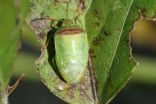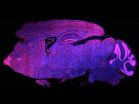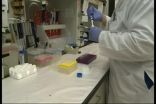Entomologists sniff out new stink bug to help soybean farmers control damage
2015-08-24
(Press-News.org) BEAUMONT -- Entomologists in Texas got a whiff of a new stink bug doing economic damage to soybeans in Texas and are developing ways to help farmers combat it, according to a report in the journal Environmental Entomology.
Various types of stink bugs have long been a problem on soybean crops, but when sweeps of fields in southeast Texas netted 65 percent redbanded stink bugs, entomologists realized this particular bug had become the predominant pest problem, according to Dr. Mo Way, an entomologist at the Texas A&M AgriLife Research and Extension Center in Beaumont.
The problem was no one in the U.S. knew much about the redbanded stink bug and how it had been able to overcome the previously predominant southern green stink bug, green stink bug and brown stink bug, Way said. An insect's life cycle and biology have to be understood before scientists can figure out ways to control it.
Texas farmers plant a little less than 200,000 acres of soybeans a year, according to the U.S. Department of Agriculture's National Agricultural Statistics Service.
"The redbanded stink bug has been a serious pest of soybeans in South America since the 1960s," said Dr. Suhas Vyavhare, a postdoc at the Beaumont center who began his work on the insect as a graduate student there. "It was never a problem in the United States until around 2000. Prior to that, it was known to be in the soybean fields, but that's when it was first reported in Louisiana as being an economic pest."
Not only did the research team find insect numbers at economically damaging levels in Texas but also determined that the redbanded stink bug was becoming resistant to the organophosphate chemical that previously had provided effective control, said Vyavhare, who collaborated with Way and AgriLife Research entomologist Dr. Raul Medina in College Station.
"We started by looking at population dynamics, or how abundant redbanded stink bug is in Texas," Vyavhare said. "We did sweep net surveys across various commercial soybean fields in southeast Texas. We also looked at insect-plant interaction in order to determine what soybean growth stages are most susceptible to redbanded stink bug damage so we could target pest management practices."
He said the researchers also had an inkling the redbanded stink bug was responsible for what is known as delayed maturity syndrome in which the soybean plant does not grow at its normal rate. They tested this theory by subjecting a controlled growth of soybeans to different densities of redbanded stink bugs and found that the insect is directly connected to the disorder.
"There are more than 50 species of stink bugs found in soybeans. Some of them are beneficial and some are pests," Vyavhare said. "The redbanded stink bug as compared to the other pest stink bugs is smaller, and it has the ability to fly faster. So it is very agile, and that contributes to its movement into different areas, and it could be one of the reasons why it is not that susceptible to insecticides because when a farmer sprays the field, they could be escaping before the chemical reaches them."
Finding that the insect is becoming resistant to the common insecticide used as well as the fact that more frequent doses were required to control them was a significant point in the research, Vyavhare said.
"Now we are recommending that farmers use different products rather than the same one over and over," he said. "So that could reduce the amount of insecticide that is applied. Even if we can reduce the need for one insecticide application, that could save millions of dollars in Texas and the other infected states each year."
The team is also hoping to continue research with other control possibilities such as using a trap crop planted near soybeans to attract the insects away or developing redbanded stink bug-resistant soybean varieties.
Way said the team also is revising a soybean pest management guide last published in 1999 so farmers will know steps that can be taken to reduce crop damage from the redbanded stink bug.
INFORMATION:
[Attachments] See images for this press release:

ELSE PRESS RELEASES FROM THIS DATE:
2015-08-24
Philadelphia, PA, August 24, 2015 - Antibiotic-resistant bacteria are a concern for the health and well-being of both humans and farm animals. One of the most common and costly diseases faced by the dairy industry is bovine mastitis, a potentially fatal bacterial inflammation of the mammary gland (IMI). Widespread use of antibiotics to treat the disease is often blamed for generating antibiotic-resistant bacteria. However, researchers investigating staphylococcal populations responsible for causing mastitis in dairy cows in South Africa found that humans carried more antibiotic-resistant ...
2015-08-24
Cancer researchers are constantly in search of more-effective and less-toxic approaches to stopping the disease, and have recently launched clinical trials testing a new class of drugs called BET inhibitors. These therapies act on a group of proteins that help regulate the expression of many genes, some of which play a role in cancer.
New findings from The Rockefeller University suggest that the original version of BET inhibitors causes molecular changes in mouse neurons, and can lead to memory loss in mice that receive it. Published in Nature Neuroscience on August ...
2015-08-24
Resveratrol, a compound found commonly in grape skins and red wine, has been shown to have several potentially beneficial effects on health, including cardiovascular health, stroke prevention and cancer treatments. However, scientists do not yet fully understand how the chemical works and whether or not it can be used for treatment of diseases in humans and animals.
Now, researchers at the University of Missouri have found that resveratrol does affect the immune systems of dogs in different ways when introduced to dogs' blood. Sandra Axiak-Bechtel, an assistant professor ...
2015-08-24
In a new effort, researchers from the University of Pennsylvania and Baylor College of Medicine have used advanced imaging technology to fill in details about the underlying cause of canine diabetes, which until now has been little understood. For the first time, they've precisely quantified the dramatic loss of insulin-producing beta cells in dogs with the disease and compared it to the loss observed in people with type I diabetes.
"The architecture of the canine pancreas has never been studied in the detail that we have done in this paper," said Rebecka Hess, professor ...
2015-08-24
Black bears in Yosemite National Park that don't seek out human foods subsist primarily on plants and nuts, according to a study conducted by biologists at UC San Diego who also found that ants and other sources of animal protein, such as mule deer, make up only a small fraction of the bears' annual diet.
Their study, published in this week's early online edition of the journal Methods in Ecology and Evolution, might surprise bear ecologists and conservationists who had long assumed that black bears in the Sierra Nevada rely on lots of protein from ants and other insects ...
2015-08-24
For pregnant women who are at low risk of complications giving birth, the risk of newborn death and maternal complications is similar for obstetric deliveries by family physicians and obstetricians, according to a large study published in CMAJ (Canadian Medical Association Journal).
"It is common to assume that more specialized or higher-volume medical care will result in improved outcomes," writes Dr. Kris Aubrey-Bassler with the Primary Healthcare Research Unit, Discipline of Family Medicine, Memorial University of Newfoundland, St. John's, Newfoundland. "The obstetric ...
2015-08-24
A new Canadian guideline aims to ensure that pain during vaccination is minimized in both children and adults. The guideline, published in CMAJ (Canadian Medical Association Journal), is targeted at all health care providers who administer vaccines.
"Pain from vaccinations is common and can make people hesitate about getting future vaccines even as adults," states Dr. Anna Taddio, Senior Associate Scientist at The Hospital for Sick Children (SickKids), Toronto, Ontario, and Leslie Dan Faculty of Pharmacy, University of Toronto. "This can put people at risk of contracting ...
2015-08-24
Today's workforce is highly sex-segregated -- for example, most elementary school teachers are women, while most chemistry professors are men. Indiana University Bloomington researchers Bianca Manago, a doctoral student in sociology, and Cate Taylor, an assistant professor of sociology and gender studies, examine one important consequence of this occupational sex segregation: the stress exposure of women working in highly male-dominated occupations.
"We find that such women are more likely to experience exposure to high levels of interpersonal, workplace stressors," Manago ...
2015-08-24
Indiana's strict voter identification law may have prevented some elderly citizens from voting in the last two presidential elections, but there's little evidence it kept large numbers of voters from the polls, according to research by Indiana University Bloomington doctoral student Adam Nicholson.
Nicholson compared turnout figures in the 2000, 2004, 2008 and 2012 elections in Indiana and in Nebraska and Pennsylvania, two states without voter ID laws. Unlike most previous research on voter identification laws, the study examined data at the county level, not the state ...
2015-08-24
Atlanta, GA - August 24, 2015 - Individuals who received the flu vaccine were protected for up to 6 months post-vaccination, the duration of most flu seasons, according to a study presented at the 2015 International Conference on Emerging Infectious Diseases.
Each flu season, researchers work to find out how effective the flu vaccine was in order to measure its value as a health intervention. Factors such as age and health of an individual, as well the level of similarity between the flu virus and the flu vaccine can play a role in how well an influenza vaccine works.
"Few ...
LAST 30 PRESS RELEASES:
[Press-News.org] Entomologists sniff out new stink bug to help soybean farmers control damage


